Beans and rice, a significant staple in a prepper’s pantry…or, should be. And, if the 2020 pandemic has shown us anything, it’s that we can never be too prepared for shortages of any kind. Prepping or pandemic aside though, I just happen to love having beans and rice in the house. There are so many things you can do with them.
In addition to the many recipes you can use beans and rice in, there’s my dog. Every once in a while, he needs to go on a very strict diet for his digestive system, and that includes mostly rice. Unfortunately, he hit one of those times in the last couple weeks, and sure enough rice was the latest shortage in the stores in my area.
So in this article, I will be letting you know a very simple way to dry can rice and beans to last you for at least 20 years on the shelf. And as soon as the shortage is over, I will be doing a much larger batch than I currently am able to do for this demonstration and article.
Sure, you could store the beans and rice in plastic storage bins. But that won’t prevent bugs and larvae from getting in eventually. In fact, when you open the bags and boxes of beans and rice before dry canning, inspect them thoroughly. However, this process will kill off unseen bugs or larvae that you might miss.
Related: How to Keep Moisture and Pests Away from Your Food Stockpile
Supplies for Dry Canning Beans and Rice
Not only is the process quite simple, but the supply list is quite short. Here is what you will need or want:
- Dry Beans – any type of dry beans, or a variety
- Rice – any type of rice will work
- Canning Jars and lids – whatever size you prefer
- Funnel – not necessary, but might make it easier
- Oven.
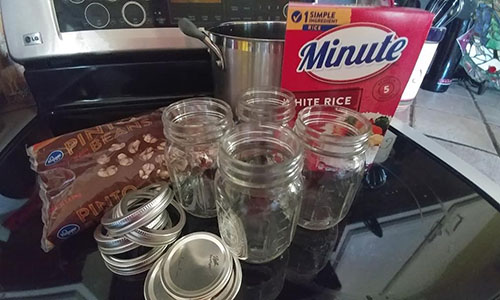 I need instant white rice for my dog, so that’s what we typically purchase. But it could be long grain, brown, flavored, instant or long cook. It doesn’t matter, any type can be dry canned.
I need instant white rice for my dog, so that’s what we typically purchase. But it could be long grain, brown, flavored, instant or long cook. It doesn’t matter, any type can be dry canned.
For the beans, I love all beans, but I’m using pinto beans for this demonstration. I will also do this with black beans, and split peas in the future, because I use both quite often. You could also do some jars of mixed beans for bean soups.
It’s also good to know too, that both rice and beans can be purchased in bulk. So, if you want dozens of jars of each, no problem. Just know that if you are in an area similar to mine right now, you might have to wait until the shortages are over, before you can do large batches.
Step 1
Place the jars into a pot with about 1” of water and a splash of vinegar for a steam bath (about 15 minutes), to sterilize them. Let them steam for about 15 minutes, with the cover on the pot.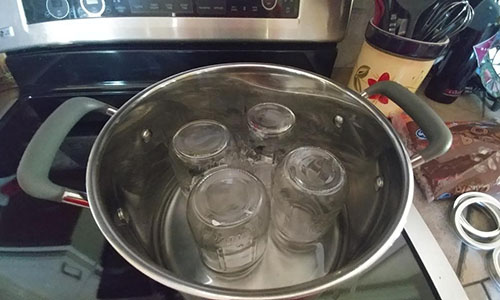
Step 2
Thoroughly dry the jars by first wiping them with a clean cloth, then placing them in the oven at 220° until they are thoroughly dry (about 30 minutes). Let the jars cool down completely before the next step.
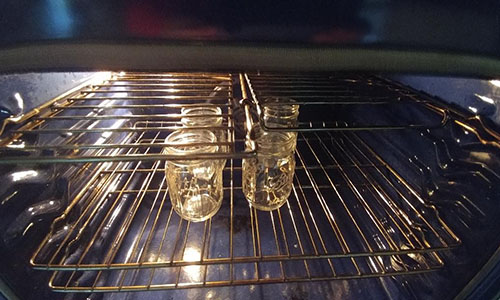
Step 3
Fill the jars with the rice or beans, with about ¾ air space at the top. Make sure that the rice and beans are not wet or moist at all. If there is any moisture, it will start to cook in the next step, which defeats the entire purpose of dry canning. It will also wipe out the main perk of all the work, because it will not result in a good shelf life.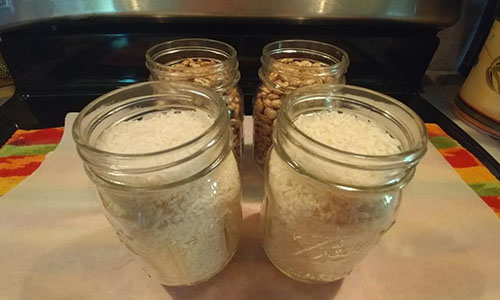
Step 4
Place the jars (without lids) in the oven at 220° for about 60-90 minutes, depending on the size of the jars. The larger the jar, the longer the time.
You can place the lids in a small pan and then place the pan in the oven for the last 15 minutes, which will sterilize them, as well as heat them up for a good seal.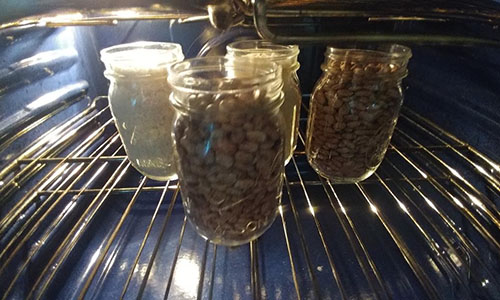
Step 5
Pull the jars out of the oven, one at a time if you have a large batch. Wipe the rim of the jar to make sure you don’t have any debri on it, that could prevent an appropriate seal from taking hold.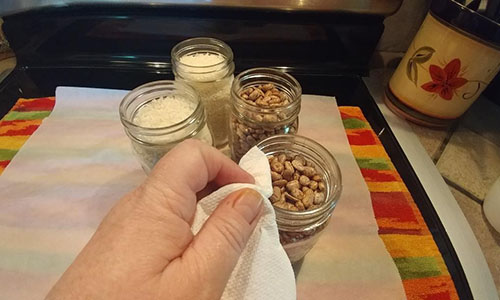
Step 6
Tighten the lids securely, and place the jars aside. Wait for the popping to begin! The seals will start to pop, but if they have not popped (center of lid’s dome pops down) then you don’t have a seal. You should start the process again, if they have not sealed after 12 hours.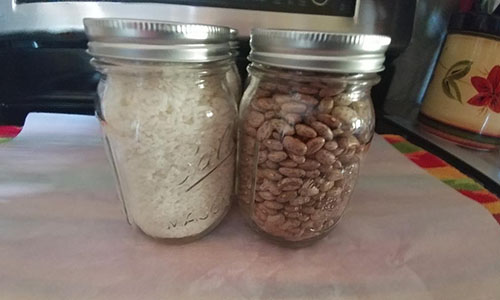 Now that the beans and rice have been dry canned, you can store the unopened jars for at least 20 years. Some people swear that they have had success for up to 30 years.
Now that the beans and rice have been dry canned, you can store the unopened jars for at least 20 years. Some people swear that they have had success for up to 30 years.
Other items you could dry can include the following: dry pasta, dry oats, dry flour, dry spices, baking soda, baking powder.
With everything changing so fast, adaptability has never been more important. It’s no longer enough to rely on modern shortcuts. To be truly resilient, you need to take control of essentials like food production and preservation.
Thta is why I turn to this guide for straightforward ways to preserve food and make survival meals that keep. With more than 100 recipes designed to last without refrigeration, it’s the resource I count on to help me stay prepared and well-fed no matter what.
You may also like:
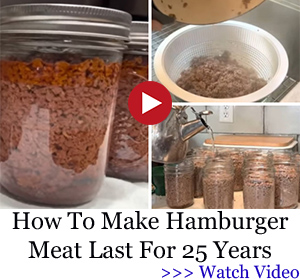 10 Items That Vanished When the Great Depression Hit
10 Items That Vanished When the Great Depression Hit
The Only Food That Grows Almost Faster Than You Can Eat It (Video)
Why a Civil War Is Now More Probable Than Ever

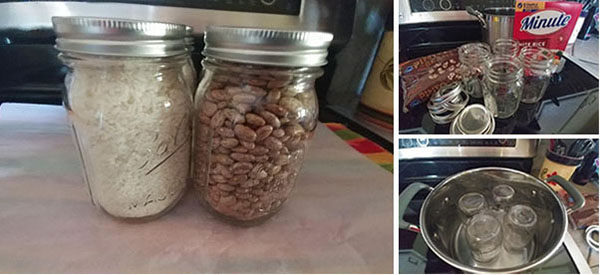




















I put 3 pounds of beans or rice sealed in a 1 gallon mylar bag with one 500cc oxygen absorber packet. I think this will give the same result for the shelf life.
I put the rice and beans in separate mylar bags and stored them in a sealed 5 gallon plastic bucket with handles to easily move and added the oxygen absorber packet….when I took them out to donate because I no longer had enough space to keep them they were as fresh as the day I put them in the plastic bucket five years ago.
Hi, good article! I’m thinking of alternatives to the oven because I don’t have one. I have quart jars and huge amounts of dry stuff to jar, and I much prefer jars to Mylar after having to deal with rats.
Could I use a desiccant (I’m in a very humid place and constantly watch the hygrometer) with an oxygen absorber instead of doing the oven heating? Anything I need to consider if I do it that way?
Or I could try to befriend someone with a fancy double oven lol. TIA!
Where do you live? I have a double oven I’d be glad to share. I’m in upstate South Carolina.
Followed the instructions to the T but my beans as they are cooling appear to be condensing inside the jars. They are sealing just fine, just wondered will the condensation affect longevity
Marti
I am finding the same thing. A little condensation inside the jars but getting good seal. Do I need to redo the batch?
Check out RoseRed Homestead for reasons not to dry can!
since there will be no expansion, why is there need for head space? filling completely would reduce the amount of oxygen in each jar and would put more food in each jar. i wonder also, why not put the lids on before heating in the oven? closing the jars after they come out of the oven allows at least the theoretical possibility of contamination when closing…and handling the hot jars and lids might result in a burn or drop of hot materials. what do you think? is there any published data about this technique?
You need to heat and expand the air inside the jar. You then put the lid on and as it cools it creates a vacuum. The jars would explode due to the expansion if placed in the oven sealed. You could loosely place the lids and then screw right down when removing, this would entail less handling of hot items.
Why, then, do you put the lids on the jars before pressure canning? Same thing, different heat transfer method.
Pressure canning is wet pack method. You never pressure can dry foods. There is always a liquid when you pressure can. Dry pack canning is exactly what is says, dry, hence the hot air expansion etc, etc.
I put rice and beans in oven for 60 min 16oz jars along with 4 quart jars of rice (left them in). The 16oz jars sealed and then I saw moisture in both. Did some of the beans/rice cook? What did I do wrong? Beans and rice were in bags. I took them out and dried the jars and will try again.
Hi! I am affraid of inflation and problems ahead for America. I want yo store food but am confused at where to start because I hear good things about different methods. Dry canning, pressure canning, mylar bags, special buckets, and seal bag machines. How do you know which to choose?
I use different methods for different type of food. Just like I use a water bath to can pickles and jams, but a pressure canner for less acidic green beans. Dry canning is for items which need to stay dry, such as flour, sugar, dried beans. I also have a foodsaver vacuum sealer machine.
Are you suppose to freeze beans, rice, flour, or any dry goods before dry canning? This will be my first time canning anything. Any advice will be greatly appreciated.
I put my beans and rice in jars as soon as I get them home, but I sure do like this idea a lot.
I have vacuum sealed rice with good results. Of course, I am nowhere near 20 years with it. I’d be curious if anybody else has tried that and has any experiences to share?
I am at the 10 year mark for rice in buckets…the rice I’m using seems to be as fresh as any; some 12 years.
I even put some in cleaned, dried soda 2 liter bottles and that is fine..no absorbers or any pre-treatment.
We forget common sense sometimes and make things so damned hard that should be so easy…like storing rice long-term!!
Have a good day.
Agreed. Can you tell me how you did your items for the buckets & soda bottles? Is your soda bottles plastic?? Which items for which??
Why can’t you buy 5 gallon buckets of beans already sealed up. Potatoes dried in 5 gallon buckets. other things ready made and packed for storage?
Well of course you can…..IF you can afford it! This is a storage solution for those of us on a T I G H T budget 🙂
The issue I see with storing in a 5 gallon bucket, is the fact that when you open it and you do not use the entire bucket of food right away, you still have to can the rest to keep for what ever amount of time you need. A single person, or a couple need smaller portions that can be grabbed without damaging any other. Unless you have already portioned the 5 gallon container using bags or jars that will hold smaller quantities and are easy to grab.
Micho:
Either repack in mylar with oxy absorbers or do what my dad did with his fish bait (fish eggs) at the end of every season: throw a lighted match inside and seal the bucket. The match uses all the oxygen and then voila!
He never had a bad jar of fish eggs, ever.
DON’T combine the two: mylar and a match!!!
Some people do up 1 portion of the food in smaller mylar bags with the oxygen absorbers, fill the bucket up with these, and seal it. That way there is no problem opening it up and removing a bag or two .
So if I bought a 20 pound bag of rice ut would not last long?
white rice will last many years if kept dry, at room temp or cooler, and protected from insects and other critters who want to eat it before you can. it has much less nutritional value than whole brown rice, but brown rice will become rancid in months unless chilled or frozen.
You can buy everything you might need, BUT it’s the cost of it. If yoou have money to burn then do it with my blessing. These good folk are teaching a way of DRY Canning to help us save money and prepare our food.
It is much easer to go to the Home Storage Center of the Church of Jesus Christ of Latter-Day Saints & buy all this and more. Already canned with oxygen absorber packets & a 30 year shelf life.
https://store.churchofjesuschrist.org/usa/en/food-storage-3074457345616678849-1?pageView=grid&fromPage=catalogEntryList&beginIndex=0
You may find a Home Storage Center near you; there are 140 in the USA
That takes the fun out of it. I look forward to canning my own stuff.
A case of 6 cans at 5.2 pounds each of pinto beans for $50.00 or a case of 6 number 10 cans od quick oats for $36.00. Seem reasonable if you don’t want to do it yourself.
Mormon Home Storage Store.
I see some potential problems with using this method:
EXPENSIVE – I can a whole lot. Jars are very expensive. For the amount of jars needed to store the equivalent of a 5 gallon pail, cost would be prohibitive.
SPACE – 5 gallons worth of rice/beans in jars would require a lot more space than a bucket.
BREAKAGE – God forbid an earthquake or something else, broken jars and your product cannot be salvaged.
Personally, I use mylar bags, Diochemateus Earth (DE) sprinkled in and mixed to kill any possible bugs, seal the mylars and put the lid on the storage bucket. I do “can” dehydrated foods by putting them in jars, using an oxygen absorber and sealing the jars with a vacuum sealer. Never had any problems.
I do not use Diochemateus Earth inside my mylar bags for bugs because I freeze all products at -10 farenheit for 3 days. I have read this will kill all bugs AND their eggs. Rice is especially bug-prone.
Yes Expensive , and Energy Intensive !
Boiling, Baking, and lots of TIME processing each batch !
IF was was going to use my canning jars for this, I would vacuum seal them.
Wouldn’t vacuum sealing be more work intensive? I’m imagining sealing one jar at a time unless you have a way to it en masse?
No. Only takes a few seconds for each jar.
Not much longer that screwing on a lid !
I haven’t had a single jar break in the year I been canning though I haven’t tried dry canning. One advantage to using jars is having various smaller sizes that you can grab without compromising the rest. Especially for a single person or a couple who may not go through five gallons quickly. Possibly even gifting or trading.
I’ve always put my bags of dry foods in the freezer to kill any bugs. Then get them ready for storage.
Has anyone else done that?
Can you do flour and sugar
You could, but those item do not keep as long.
Wheat should be stored instead of flour.
Invest in a good grinder to make your own flour.
Sugar is a natural preservative so as long as it’s in a tightly sealed container you do not have to dry can it. Also the sugar might melt.
Yes i have Dry canned flour for years. i haven`t done sugar because it keeps good just in a air tight bucket. I dry can at around 200 degrees Fahrenheit for 2 hours. I put my lids in the oven at 1h 45 min. after 2 hours i screw lids on and turn oven off leaving jars to slow cool in oven for another half hour before i remove and cool at room temp. I know it is a little extra work but i don`t have any problems that way.
sugar will turn into a solid block
This is fantastic information, KJ Barber! I have 40 lbs of beans and half-gallon jars, to begin with. Thank you very much for this article!
You cannot so this with brown rice unless you plan to eat it within a year or so. Brown rice has too much oil to store for 20 years. It will go rancid. You can only store white rice for that long either by dry canning or in mylar bags with oxygen absorbers in plastic buckets with a gasket.
There should be no need to put a PROPERLY sealed mylar bag with an oxygen absorber inside of a food grade bucket with a seal/gasket lid. If your mylar bags are thin enough to let light in then putting your sealed mylar bags inside of anything that will keep light out should suffice.
As for brown rice, I too have read exactly what you said.
If you do not store mylar bags in a container rodents will eat through it.
Rodents can eat through mylar, so I always put mylar bags in a bucket or tote bin.
I put 25 to 30 pounds of beans or rice in a mylar bag (not absolutely necessary) , put the bag in a five gallon plastic bucket, throw in an activated handwarmer as an oxygen absorber and hammer on the lid nice and tight. The lid must have an O- ring (Home Depot buckets and lids are great). I can then stack the buckets three to four high. Also this is relatively inexpensive and is not in danger of breaking.
We have used this method for about the last 14 years. I certainly work…in that if done correctly the jars retain a good seal. The down side however is that after about 10 years of storage many of the food items reflect a significant decline in nutritional value. We expected some, but for flour/grain items it is significant. Better stock up on lots of vitamins, and don’t try to store processed grains/flour too long. Keep things like wheat berries to grind later.
negative about using the oven dry canning method is heating up the stored food – never a good thing …
you can sterilize the jars & lids the same way but use a 100cc 02 absorber or the jar attachment for the vacuum sealer to long term store dry goods food for a few decades …
I’d like to hear from someone who has stored dry beans this way or any other way for at least 5 years and then cooked them. If beans are just put on the shelf in their store packaging, they are practically inedible after 2-3 years. No matter how long they are cooked, they do not soften completely. Do these methods prevent that problem?
Do not throw away those old beans. Rather, grind them into a flour.
What would you use the bean flour for?
In 2012 I put 50 lbs each of Red Beans, Pinto Beans, Black Beans and Lima Beans, Rice, Corn Meal, Flour, Corn Flour, Salt and Sugar in Home Depot buckets without mylar bags.. I kept them in an air conditioned shop until March of this year.
Last month I opened each up. The only failure I had was one bucket of Corn Flour cracked at the bottom and insects contaminated it. I cooked test meals with everything else. My wife, who is fastidious about what she eats, approved of all.
We own a VacMaster chamber sealer and I repackaged all into 5 lb bags and moved them to our kitchen. The VacMaster will also accommodate 6 pint canning jars at a time. I keep things like yeast in jars and seal them after each use
You did not use any moisture absorbers or vacuums just the Home Depot bucket and its own lid?
I am eating brown beans for dinner today.
Stored in a 5 gallon bucket many years ago–like 2008/2009, no special treatment, just put is a bucket, DE added for bugs, etc….and lid banged on.
I always soak my pinto and white beans in baking soda for a few hours or the night before and they cook well.
DG now has a 4 lb. baking soda box for $2.
No trips to sam’s club now.
Thank you, that is my question as well. I even tried baking soda as reccomended by a neighbor to soften old beans with no success. My other question is where to get the mylar bags everyone keeps mentioning. Inquiring minds & all… & I don’t have a vacuum sealer.
foil pouch:
https://store.churchofjesuschrist.org/usa/en/food-storage-foil-pouch
oxygen absorber:
https://store.churchofjesuschrist.org/usa/en/oxygen-absorber-packets-300cc
Yes. No success with several tries to cook old pinto beans.
Tough beans might be a matter of taste. I’ve pulled out beans 4-5 years old, rehydrated overnight w warm water and baking soda, then cooked them. For me, they were tasty, edible too hard or grainy but for others, they were fine.
Also, for old beans, you could try germinating them, might get one out of five that you will grow. Like someone else said, you could grind them and use them like any other flour to make things like fry bread or griddle cakes. It’s common in Indian cuisine.
I have cooked them after storing for 22 years. I had to soak overnight and cook longer but tasted just as good as from the store.
Dry canning is a really terrible idea. Beyond the risks for breakage and the high cost of jars and lids, heat is one of the four enemies of food for long term storage. Heating the food for 60-90 minutes before canning only kills bugs, drives out moisture, and shortens the shelf-life. It does nothing against light or oxygen.
Unfortunately, KJ either didn’t do enough research or didn’t bother posting it. If you contact Ball/Kerr they will inform you that dry heat is NOT recommended for their jars, nor is it approved. It can weaken them and cause breakage.
Additionally, I don’t understand the need for using an oven when a vacuum sealer does the exact same thing without heating up the food to a cooking temperature.
Please be smart about your food storage. Double check methods mentioned EVERYWHERE on the internet…including here.
Many people dry can. Their jars do not break. Ball isn’t going to approve it! They have liabilities. One thing that gets tiresome is all the preppers who answer with superior tones. What one likes others may not. Just make your suggestion and leave it at that.
I have used dry beans as weights in pie crusts…and then used them in food… yuck…. nope… dry heating beans and then using them for food does not work. Ruins the beans. So… will NOT use this method for storing beans or rice. Will go the mylar bag and DE method. Thanks for the tip.
Many of us can’t afford a vacuum sealer. Especially not the better ones.
I am interested to try a different method. I read you can use nitrogen and a small candle.
Fill your bucket to within 2 inches of the top, place the small candle on top and light it, stick a wand clear to the bottom of the bucket attached by hose to a Nitrogen tank and start the air supply. As the Nitrogen fills the bucket it replaces the oxygen until the candle goes out. Then throw in an oxygen absorber and hammer on the lid. I read a testimony that grain sealed like this was still good after 40 years.
N or CO2 same results. To drive out the O.
what about using a vacuum sealer with lid attachment? aren’t you essentially doing the same thing in half the time?
I purchase #10 cans of dried goods from the Church of Jesus Christ of Latter day Saints. When I open a fresh can of freeze dried poduct I seal them in regular canning jars and lids with my electric vacumn sealer. If i don’t have electricity I will use the oven option or store in regular jars. Better than nothing
I have just tried canning split peas, black beens and kidney beens and my jars once sealed had moisture droplets in them. I unsealed and set the peas back on a cookie sheet to dry up. But everything was sterilized and dry when i put them in the over. why would that happen?
because even tho dry to the touch, grains, legumes, etc, have a small amount of moisture in them. the heat of the oven brought this out. perhaps yours had more than most. or perhaps you looked at yours before the moisture reabsorbed. this really isn’t the best way to keep beans long term as if you really get them dry they never cook completely soft. plus it is using the canning jars in a way they weren’t made to be used, making them just a bit more likely to crack. beans keep many years in a jar or can on a shelf in the dark in a cool room.
I have had beans that have been stored for a couple of years cook for hours and you could use them for bullets in a slingshot. I finally figured out that there is a way to save them and lessen the cooking time when ready to prepare a meal. Now this came to me when a lady on the net started producing meals in a bag. I started using noodles to test this out and it worked great. Simply cook beans, pasta, anything you can come up with. Of course not meat so much, Once cooked just dehydrate and vac seal or use mylar bags with oxy bags and seal. What you are doing is simply making instant everything. Throw a handful of noodles in a bowl and add boiling water and spice to taste. It works really well, and you can simply put in 5 gal pails or tins. I have lived the preppers life style for most of my life. Growing what I can, finding what I can in the forest and my yard, wild game in season, etc.
I am 74 and still fairly active. Still enjoy learning. For meals in a bag just search for them right here on this site and it should come up.
Rodents can chew through mylar bags and plastic buckets. Just saying!
@RayK you put lids on for pressure canning but not so tight that the air cannot vent out.
The Mylar bag prevents rodents chewing plastic pail as then they can’t smell it! JR
Isn’t it true that you’re doing the same thing in half the time?
if drug sniffing dogs can ferret out marijuana in mylar, maybe inscts can find your stored food also.
Have never had a insect or rodent chew through mylar plus plastic pail but have had the sad experience of that not being true with just the pail! however I am not against using glass canning jars. I just cannot prep all of my supplies for 20 people that way, But I do some that way. jr
I made space for some jars, going to try dry canning beans and rice. The space created was formerly occupied by beans and rice in their original bags from 2009-2010. I’m thinking if I had dry canned initially, I wouldn’t be changing them out. Someone mentioned sprouting old beans, so I’m trying that with two old bags of black beans in a couple of buckets outside.
Great success with this today! Canned 6 quarts, 9 pints and 5 half pints of rice (some instant, mostly regular) today using your method. The only thing I did different from the original instructions, after reading the comments was, put the lids on loosely in the oven, instead of after taking them out. Glad I did, I turned one over trying to get it out, and that would have been a mess (and loss) to clean up! Thanks so much for sharing this! I didn’t want to waste that rice!
Just noticed moisture in the one quart of instant rice…none in the 2 half pints of instant …not sure of the significance but probably won’t attempt instant again. Live and learn.
if i store beans and rice in mylar bags will insect eggs and larvae remain alive and destroy my contents ? I had thought the purpose for 220 degree dry canning was to kill all eggs and larvae ?
since rice and beans are dry to begin with why not just jar them? wouldnt that work? also how about sealing in vacuum seal bags, any problem with that? should there be a oxygen pack in either of them? thanks
Lots of interesting ideas here. I personally like to pressure can most things. Remember that in a grid-down situation, you will need not only water, but fuel and time to properly cook most items. With pressure canning, food is not only OK for 10+ years (especially meat and beans), but the jars can just be opened and eaten. With the white rice, I guess I just do my best to keep it sealed and dry, and hope for the best. The big downside of pressure canning is if you need to uproot and leave in a hurry. For this, I would recommend the very expensive freeze-dried preparedness buckets.
I meant to say that I have pressure-canned some extremely old beans (some guy put buckets of his Y2K stock on the curb when he figured out the world didn’t end). They had no O2 absorbers- just loose beans in 2 Gal. plastic buckets. I pressure canned them and they were absolutely fine to eat 3 years later.
I also found that with semi-rancid brown rice, if it is not too far gone, it can be pre-boiled and then pour off the original boiling water before cooking. This seems to remove most of the rancid oils. It is not the best flavor compared to fresh brown rice, but is perfectly edible.
Disclaimer: The shelf-life and safety of anything I have posted is a matter of my opinion and information I have gleaned from others, and should not be taken as expert advice.
Is it 220º F or 220º C?
can you use other jars besides a mason jars? Such as pickle jars?
Is it necessary to place dry canning in oven if you have one of the new vacuum sealers that fit over the jars and quickly seals the jars? Other than getting the jars hot enough to seal the lids what other purpose is heating in the oven? I’m new to canning and just learning. Thanks